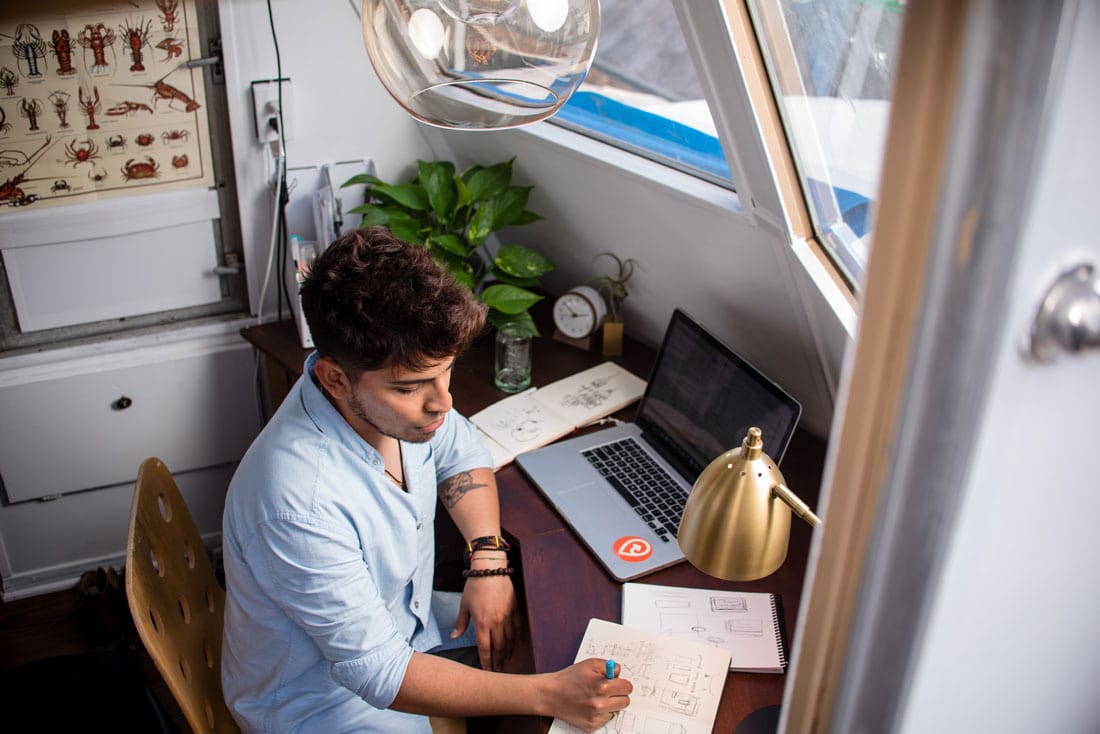How to Be a Freelance Graphic Designer in 2022: A 10 Step Plan
Do you have dreams of ditching your day job and becoming a full-time freelance graphic designer? Start putting your plan in motion.
Most freelancers start with graphic design as a side hustle, but with determination, business planning, and a solid work ethic, you can build as much business as you want to create a sustainable career.
Here are 10 steps to help you get started.
Trust me, I’ve tested them all in my decade as a freelancer!
Step 1: Start Building a Portfolio

A strong portfolio is a must if you plan to bring in clients on your own.
While it can be tempting to dump everything you’ve done recently into a portfolio, be selective. Only include projects and examples that are stellar examples of the kind of freelance work you want to do. (If you plan to focus on print, don’t pack your portfolio with digital projects.)
Use your portfolio as a showpiece to sell your work to potential clients. You’ll quickly find that the type of work you showcase often results in similar inquiries for future projects.
Step 1a: Include passion projects in your portfolio. Even unpaid projects that you have a personal connection to can be part of your portfolio. Sometimes these pieces can show your depth of work and love for design more than commercial jobs. (They can also lead to more of the kind of work that you want to do.)
Step 2: Establish a Personal Brand
You’ll need a strong personal and professional brand to make it as a freelance graphic designer. They might be the same (if you plan to do work under your name) or could include a business name that you represent.
Buy a domain, create an email address, and establish an online presence as a graphic designer. While you are doing this brand work, consider whether you plan to do freelance work under your name or create a business name. (You might want to do the footwork for both if you are on the fence.)
There are pros and cons to both options – using your name or creating another company name – making it a personal choice of how you want to do business as a freelance graphic designer.
I started doing small freelance projects under my own name nearly a decade ago. As my business and reputation grew, I incorporated the freelance business. This is a common path for many freelancers and shows how a strong personal brand can grow into and contribute to a business name or brand as well.
Step 3: Get Online

Part of building your brand is to establish yourself as an authority in all things design, with a specific focus on the type of freelance work you want to bring in. That probably starts with a website as well as social media and portfolio sites.
Think of how new clients will look for you. It will likely start with a Google search – even for clients that come from referrals.
A strong online presence gives you credibility as a graphic designer and makes you “real” to potential clients. It can also provide a point of contact. So don’t forget to include a note that you are available for hire and how to get in touch.
Step 4: Create a Business Plan and Goals
So much of becoming a freelance graphic designer isn’t creative at all. It’s laying a solid business foundation to facilitate future success.
If you plan to use freelance work as merely a side gig, a full business plan might not be necessary. But you still need to think about time, taxes, and the balance of revenue and expenses. (The goal is to make money, right?)
If you plan to enter into freelancing as a full-time job, you need a business plan and goals. How much income do you need to make it work? What about costs from healthcare to taxes to software and computers and marketing? What services and contractors do you need (legal, CPA, licenses, and insurance)?
Create measurable goals to help you figure out if your plan is working. And have a fallback plan if the freelance lifestyle ends up not being for you.
Step 5: Start Taking Clients
Start taking freelance clients.
While you are probably ready to jump in, it’s a good idea to start small. The first few clients and projects might take more time or work than you anticipate. From meetings to revisions to figuring out what exactly a client needs, you want to give yourself plenty of time to be successful (and not burn out right away).
Over time, you’ll get an idea of what client time looks like, how long certain projects take, and where you can focus on making the most money and getting creative fulfillment.
Step 6: Develop and Nurture the Right Networks

What does your ideal client look like? Where do you find them?
Spend some time putting yourself out there with intentional networking. If most of your business is local, attend meetups and networking events in your region. If client work comes from other sources, develop those networks.
Other networks might include contacts at agencies if you do a lot of sub work, through design conferences if you have a wide network or individual clients that send a lot of business your way.
Strong connections will help you generate the right type of business and not lead to problem clients or projects that aren’t a good fit.
Remember that networking happens in person, online, and through other channels such as guest blogging, referring clients, and attending industry-specific events or conferences.
Step 7: Diversify Work and Clients

Don’t spend all your freelance time working for one client or on just one type of project. You never know when that business might dry up.
It’s a good idea to create a diverse client base.
The ideal mix? Aim for:
- A few regular clients with predictable needs
- A couple of big projects that you can complete and move on
- A few new clients or projects
- A passive income source such as selling UI kits or tools in marketplaces or reselling hosting to website clients
Step 8: Create a Referral Network
There will come a time that every freelancer is maxed out. You just can’t take another project because you are busy or need a little time off. And that’s OK.
Refer clients to other graphic designers that you trust. Creating a referral network that you can send clients to establishes your reputation and can work reciprocally when other freelancers refer clients back to you. Only send clients to other designers that you trust.
Have a conversation with designers that you might send clients to. These might be others that you work with regularly (or even contract work with) or designers from your extended network. Make sure they know you may send work their way. (It’s good for business in the long run.)
Step 9: Find a Niche Market
While it is good to have a mix of clients and projects, some freelancers can benefit from specialization. Do you do something that there’s a strong demand for and not a lot of people to meet it? Specialization might be the key.
Before you jump into a niche market, do your homework. Is there enough work to support your business? Can you work efficiently in this area? Will you be satisfied with one line of design work? Is there a demand for the product, service, or design technique you are specializing in?
Just because you decide to specialize in something, it doesn’t mean you can’t take other projects. The main benefit of working in a niche market is that you should be able to create a system and produce work quickly – you aren’t reinventing the wheel each time – and you have a strong familiarity with the work.
Niche markets include:
- Content or industry-specific design work
- Use of specific techniques, such as designing for voice or artificial intelligence interfaces
- Specialization by project, such as websites or print design, outdoor media, or product design
- Working with a specific type of client, such as small businesses in a certain region
Specialization doesn’t mean that you can’t change over time. Market and client needs change. Stay on top of your business and the industry. Evaluate your projects and clients periodically to make sure you are doing what’s best for your career.
Step 10: Pay Yourself a Salary

Now for the fun part – make sure to pay yourself!
Separate business and household money. Use different accounts, credit cards, and keep track of everything. Operate the freelance work as a business to make everything more manageable in the long run. (Believe me, your accountant will thank you.)
Then from the business, pay yourself a salary. (Hopefully, you’re are doing enough business to pay yourself well.) Don’t pay household bills from your business accounts. Keeping business and personal accounts separate will make for easier, and less stressful accounting over time.
Conclusion
You can be a freelance graphic designer. It’s more than a dream, and in a growing gig economy worldwide, you can find a place in the creative industry on your own.
You will have to work at it. But if freelance graphic design is something you are interested in, you can use this plan to get started.